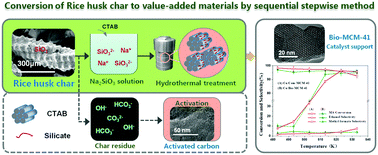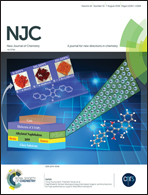Bio-MCM-41: a high-performance catalyst support derived from pyrolytic biochar
Abstract
Silica-based materials can be extracted efficiently from biochar prepared by biomass pyrolysis. A bio-mesoporous material was prepared directly after the extraction of silica from biochar using a sequential stepwise method, in which biochar was obtained as the by-product from the pyrolysis of rice husk. This mesoporous material (designated Bio-MCM-41) had a high Brunauer–Emmett–Teller (BET) surface area of 782 m2 g−1. To test the feasibility of Bio-MCM-41 as a catalyst support, Bio-MCM-41-supported Cu-based catalyst (Cu/Bio-MCM-41) was prepared for use in the hydrogenation of methyl acetate (MA) for ethanol production. The probe reaction test of MA hydrogenation showed that the Cu/Bio-MCM-41 catalyst had superior or comparable catalytic performance to a similar catalyst (Cu/Com-MCM-41) prepared from commercial Mobil composition of matter 41 (MCM-41). A high MA conversion of 91.5% with an ethanol selectivity of 96.4% was achieved under the optimum reaction conditions (513 K, 2 MPa, n(H2)/n(MA) = 60, liquid hourly space velocity = 0.8 h−1). In addition, the alkali-rich char residue was activated directly to obtain activated carbon (AC) with a BET surface area of 442 m2 g−1.



 Please wait while we load your content...
Please wait while we load your content...